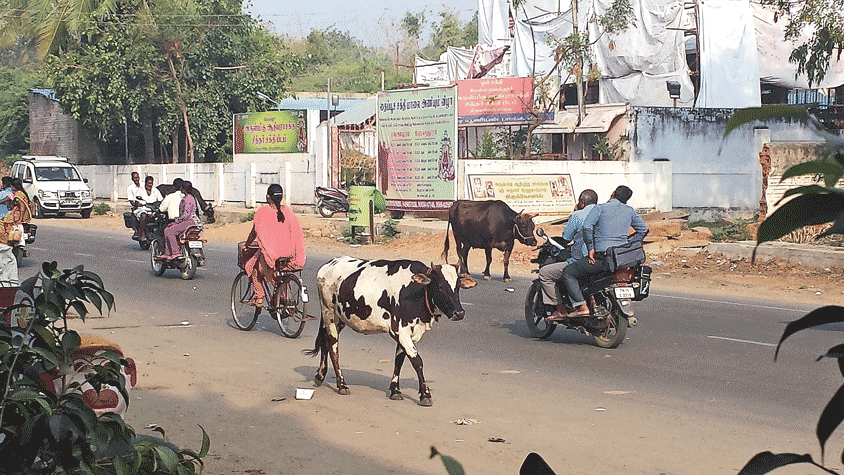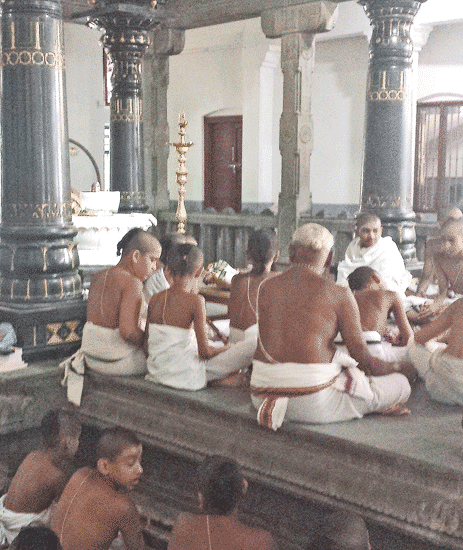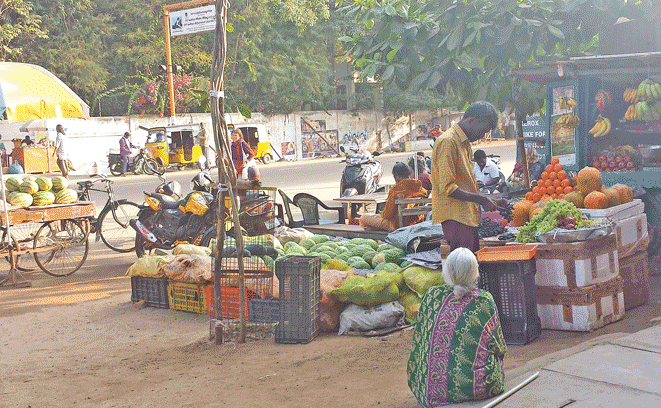
Carl Kleimaier of Elburn visited India for six weeks on a spiritual and meditation retreat in Tiruvannamalai, a city of 150,000, earlier this year. A sense of spirituality and chaos pervade the culture in India.. Here is his report:
By Carl Kleimaier
Spirituality and chaos:
India and the modern world make the individuals moving along the side of the road appear like ghosts in a shadowy-underworld. They wander seemingly lost and seek to find their way.
The cab driver is constantly honking and moving around trucks and motor bikes. Honking serves as a turn signal in India: “I’m over here. Get out of the way.” It’s not too bad on a three-lane divided highway, but when the two-lane road starts, the honking and passing feels like you are always going the wrong way. Everyone seems to think they have the whole road to themselves. Whichever car, truck, bus, or motorbike, starts passing first gets the right away, but no one really ever stops, they just slow down, move to the edge, or find some way to get through.
After a 24-hour trip to arrive in India, we pull into a long, dirt, driveway. I see a three-story white, plaster building with three cows, some chickens, and a few dogs in an unseeded front area. Next to the large metal doorway is a large, colorful statue of the Hindu god, Ganesh, the elephant-headed god who helps remove obstacles. As I look around, I think I might need his help.
I’ve come to India for a six-week meditation retreat in Tiruvannamalai, a town of approximately 150,000 in southeast India. It is the site of Mt. Arunachala, a 2,700-foot high hill considered one of the five main Shavite holy places in South India. Shavite is a name for those who worship Shiva the Hindu god of creation and destruction and god of formless consciousness out of which creation is formed and destroyed. The mountain is considered to be the physical embodiment of Shiva.
The town and the mountain were made more significant by Ramana Maharshi and Indian yogi- mystic who lived on the mountain for 53 years from 1897 to 1950. He and another famous yogi-mystic, Shri Aurobindo who lived 100 miles east of Mt. Arunachala were two of the 20th Century India’s most famous mystic/spiritual teachers and, more importantly, messengers to the West.
Although Ramana lived in a small hermitage in the mountain and wrote nothing, to leave only what his disciples recorded of his conversations and teachings, Aurobindo, on the other hand, was a Cambridge-educated scholar and an early leader of India’s independence movement from Great Britain. He wrote hundreds of pages on his spiritual process which advocated bringing spiritual awareness into the world.
When Ramana and Aurobindo died in 1950 India had a population of about 350 Million, the size of the U.S. today. It had not been hit by modernization. One article said that in 1920 there were only approximately 1,300 vehicles in India. Of course, by 1950 that would have increased, but, the only vehicles would have been government vehicles and those owned by those wealthy enough to afford cars. There were only a few paved roads so even with a car, travel would have been difficult.
Indeed, I was told that approximately 20 years ago the road in front of the Ramana Ashram (religious retreat) was not paved. But now it is a carnival midway of activity. Orange-clad holy men; westerners dressed in baggy Indian clothes wander among the street vendors selling everything from statues to bananas, not to mention a variety of individuals begging. One young woman holds a baby in one arm, the other arm had no hand. She holds out her hand from the arm holding the baby and looks with appealing eyes at passers-by for a hand out. Another young man with a withered right arm and bad limp sits in front of the grocery store and asks for handouts from people leaving the store. Some, like me give a few rupees, 20¢-30¢. If he can get 100 equal to $1.30, he can eat enough to keep going apart from what other help he has.
The side streets are usually unpaved and covered with litter and drainage ditches. This situation, on the edge of a street with constant motorcycle, bus, trucks is augmented by the occasional cow. A careless step too far into the street easily can get you hit. It is no place to check your cell phone. Slowing down for pedestrians, cars, and other trucks is a last-second decision by the driver. The largest vehicles, or the one there first, have the right of way.
Inside the ashram gates, however, things slow down in an attempt to return to the solitude that was created by Ramana in the 50 years he lived on the mountain. A clean, wide, sand walkway offers relief from the congestion outside the gate. There, individuals are quiet and even the dogs sleep quietly. There are monkeys sitting around and a few peacocks. Up this walkway on the left is a large stone building holding the burial shrine for Ramana and his mother. In the morning there is a chanting ceremony with many people sitting in mediation or doing circumambulations around the shrines.
India presents a vast contrast. On the one side of this contrast: Polluted cities. The World Health Organization recently declared the top four most air-polluted cities in the world to be in India. Millions live on the street or in plaster houses the size of a small garage with a cow or goat tied in front, with tangled traffic, litter, and trash everywhere. A recent report said “India’s capital city, New Delhi, has introduced a ban on disposable plastic.” Even worse, “despite rising incomes and living standards from India’s two-decade-old economic boom, India still has an estimated 626 Million individuals who live in households without toilets.” On the other side it’s an ancient civilizations with profound philosophical and spiritual teaching.
So against this background of chaos, what does meditation and spirituality have to offer? If we think of spirituality as feeling and believing that a power or powers greater than just ourselves are necessary for existence and for some purpose in existence, then spiritual practice in the form of prayer, meditation, rituals, or service to others are ways of increasing that feeling of connection to what is greater than ourselves and to its purpose. Traditional spirituality, whether Christian, Muslim, Hindu, Buddhist, or other paths usually include all three of these ways. The goal, then, is to reduce the feeling of separation from creation and to feel a oneness or inner feeling of connection. The more often it happens the better is the harmony between ourselves, others, and creation. Thus the Biblical injunction “Do unto others….”

Carl Kleimaier photo
Part 2: A reduction of separateness and expansion of oneness is the experience of many people who spent time with yogi-mystics Ramana Maharshi and Shri Aurobindo and other spiritual teachers in various traditions. It is what Indian spirituality has meant to the West. And it is what the many westerners I see in the streets of Tiruvannamalai, a city of approximately 150,000, are seeking.
Sitting outside a small grocery store that supplies mostly westerners with their habitual tastes and needs, pasta and sauce, western cornflakes, sliced bread, I see on a wall to my left 30 posters announcing talks by spiritual teachers. All except three are Western teachers. Now many of these teachers have studied with Eastern teachers and have had some level of spiritual awakening. The reason they are so popular with Westerners, and only a few Indians attended talks by Sat Shree at the retreat, is because they speak in a language that Westerners understand. By this I mean not just English, but they speak of the worldview that is Western. They can translate across the cultures in ways that Indian or Tibetan teachers usually cannot.
So this thirst that Westerners have is indicative of a search for a deeper meaning in their lives that has not been satisfied with nice homes, new cars, Western education. So they come to India, usually between December and March, when it is not raining, or too hot and put up with or ignore the dirt, the beggars, the trash, to live for a while, rather cheaply, and to pick up a spiritual vibe from the holy places. When I sit in a Western style café, I notice two younger persons. He seems to have a French accent. They seem to be in a relationship because he occasionally touches her hand. He is reading a book called “I Am That;” A large, mystical text by a teacher named Nisargadatta Maharaj who died in the 1980s. He seems more interested in her than in the book, but in a little small talk, I find neither of them is employed and they are living off some undefined assets for a time.
Another man I met was elderly, wearing a green dhoti (man’s garb tied around the waist) wrapped around his suntanned, shirtless skin. He tells me he went to Brown University and has a Mensa (genius) level IQ. He says something about not being able to find the knowledge he was looking for at Brown, spent some time in Hollywood working for a movie actress, and now lives in India and walks or rides his bicycle around the mountain (Mt. Arunchala), apparently, as an act of devotion.
The group I am with consists of about 40 individuals, a few of them from Sweden, and the others are from the U.S.. They are varying ages, the youngest about 30 and a few my age, about 70. Almost all have been involved in spiritual study and practice for many years and even the younger ones have had some spiritual experience that has brought them here to meditate and study with Sat Shree.
In my case, in college in the late 1960s when there was an interest in the East, I had a philosophy teacher, who had studied at Yale University with F.S.C. Northrop. Northrop wrote a book in 1947 called The Meeting of East and West, what today would be considered a cultural study text. As a result, this professor, Stewart Penn, had an interest in those traditions. We would often have discussions about Eastern philosophy and experiences. It was his open-mindedness that allowed me to explore different ideas with discrimination but without the kind of severe cynicism we often see today about anything spiritual. So I became interested in and practiced Buddhist meditation and have attended many retreats mostly in the different Buddhist traditions.
I had heard about and had been acquainted with people who had gone to India and had felt like I had missed something by not going. So when Sat Shree suggested that I go with his group, after a year’s hesitation, I decided it would be my last chance and felt I would always regret not going. I felt that perhaps it was better that I was going after years of study, meditation practice, and maturity. Now I would get more out of it than I would have at a younger period in my life. Had I gone earlier, I would have seen India less modernized but more impoverished perhaps, but I would have had lesser overall maturity.

Carl Kleimaier photo
Part 3:
Sat Shree ran an architectural business outside Reno, Nevada. Except for some spiritual interests when he was in his late teens and some involvement in self-improvement groups, he did not have an interest in spirituality. He was involved with community issues and did camping and loved architecture. He was in his late 50s and happy with his life. One evening he was sitting at his desk at home and was overtaken by a powerful, energetic experience which took him out of himself, and gave him an entirely new view of the purpose for existence. It was not a one-time event. It recurred every few days. He describes it as follows: “This state arose suddenly without any effort on my part in the midst of an individual human life in one night in 1998,” he said. “This awakening was a glimpse of an utterly different and radical state of being that I now reside in. However, back then, it was just the beginning of a process that set in motion a transformation that utterly changed reality as I had known it, a process that continues to this day.” See Sat Shree YouTube interview on Buddha at the Gas Pump webcast.
Through a connection to a friend, he made contact with an Indian teacher living in Tiruvannamalai, a city in India, population 150,000, named Shri Atmananada with the aim of getting some guidance. He spent the most part of five years living in the ashram (religious retreat) experiencing and cultivating an understanding of these deeper states of consciousness. He began his own teaching about 10 years ago. It was he who compelled me to make the six-week visit to find a deeper sense of spirituality and meditation. My decision was delayed a year to make the commitment.
One of my high points of the visit was attending a ceremony at Shri Atmananda’s ashram with Sat Shree where an ancient ceremony was performed. Over the years, attending first Catholic masses as a boy, and later Tibetan Buddhist rituals and Hindu rituals at the Amma ashram, I have come to see them all as ways of joining heaven and earth, of trying to reinforce the human connection between the visible and invisible worlds.
Perhaps it is what the sacred mountain, Mt. Arunachala, is about. On the western side of the mountain there are temples and shrines and ashrams all along the road. The three-wheeled taxi driver who took me on a tour stopped three or four times and told me how different views of the mountain reflected different views of the gods. This place was Shiva lying down; this was Shiva, Vishnu, and Brahma, standing together. For many residents in the U.S., and probably in India, the spiritual realms are not only in some beyond, but interconnected with this world. The gods are always close at hand and this world is considered more of a passing shadow. In the West, God can be personal in the form of Jesus, and although we are admonished not to store up earthy treasures, our belief in the truth of the material world is taken as almost absolute. How and if God is connected to this world is an area of discussion in theology and particularly in science leading to constant arguments about who has the truth.
I had a small private apartment in a building three miles from the ashram where meditation was held each day. I cooked meals in the apartment.
So what I experienced in India reflects, I believe, what is going on in the world as a whole. Africa, other parts of Asia, part of South America, are stuck in a physical poverty that is being overlaid with the modern, but not changed by it. There is a split between the view of reality that is secular and that which is spiritual.
Some of the terrorism in the world is at least partly based on a war against the modern world and its so-called atheism. This divide is being bridged by people such as the Dalai Lama and the people interested researching and practicing mediation and people who are generally trying to be more introspective about their lives and more compassionate to others trying to live the injunction: Love thy neighbor as thyself.

